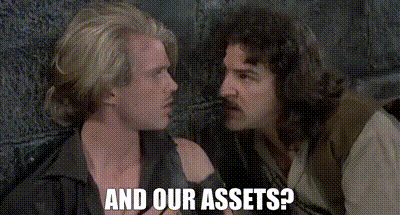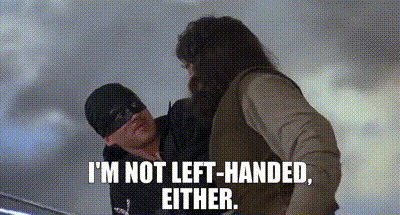I don’t have a particularly thoughtful intro for this one, just the goblin that lives somewhere in the back of my head shouting FIGHT FIGHT FIGHT FIGHT, so let’s get down to business (to defeat the Huns):
I write good fight scenes. As a general rule, I write really good fight scenes. This is in part due to the chanting goblin I mentioned and that I tend to have good visuals in my head when I write. But a lot of it comes down to the fact that at some point I realized a fight scene is just a collection of moving parts, and once you know what they are all you really have to do is find a method to keep track of them.
Yeah, I know how that sounds. I know you’re probably saying, “Oh really, Wren? Is that all? You’ve just got to keep track of a collection of moving parts?” First of all, I don’t much like your tone. Second, what you have to do is identify the moving parts and then find a method to keep track of them.
Every fight scene boils down to three essential elements: fighters, weapons, and terrain. It might be more memorable to think of them as the who, what, and where. If you’re having trouble with a fight, ask yourself the relevant questions and dig deeper as necessary.
WHO is fighting? (Fighters)
Who is the point of view character?
How does who they are as a person affect their tactics?
What is their goal?
Are they on the offense or defense?
Do they need to protect someone or something?
Are they looking to kill or incapacitate?
If they’re against multiple opponents, the primary goal should be incapacitation.
What is their skill level?
What experience do they have in this kind of situation?
Are they in fighting shape?
Are they sick? Injured?
Who is/are their opponent/s?
How does who they are as a person affect their tactics?
What is their goal?
Are they on the offense or defense?
Do they need to protect someone or something?
Are they looking to kill or incapacitate?
If they’re against multiple opponents, the primary goal should be incapacitation.
What is their skill level?
What experience do they have in this kind of situation?
Are they in fighting shape?
Are they sick? Injured?
Who is/are their ally/ies?
How does who they are as a person affect their tactics?
What is their goal?
Are they on the offense or defense?
Do they need to protect someone or something?
Are they looking to kill or incapacitate?
If they’re against multiple opponents, the primary goal should be incapacitation.
What is their skill level?
What experience do they have in this kind of situation?
Are they in fighting shape?
Are they sick? Injured?
WHAT are they fighting with? (Weapons)
Are they using real weapons or improvising?
How might they use these weapons?
Do they have experience with these weapons or something similar to them?
Some weapons require more or less skill/experience than others. While it would be foolish to say there are no tactics involved in using a club, the basic principle is easy to grasp, making it simple enough to use with the requisite strength. A bow and arrow, on the other hand, needs serious training to use effectively. This is especially true if you’re dealing with a bow with a high draw weight, calling for not just training but development of the relevant muscles.
How much range do they have?
How long is their reach, and what is their recourse if their opponent gets within their reach?
How much ammunition do they have, if applicable?
Do they have weapons at all?
What experience do they have with hand to hand combat?
Magic?
This one is a bit of a wildcard. How well you use it depends on your grasp of your own magic system.
WHERE are they fighting? (Terrain)
Is it familiar terrain? Familiar to whom?
What advantages are gained through knowledge of this terrain?
Is it a stable or a changing environment?
Stable is a relative term, since there’s little stability in any environment once a fight breaks out, but a barroom is far more stable than, say, the Dark Lord’s castle as it crumbles.
How do the weather, temperature, and time of day affect the fighters?
Light and weather may affect sight.
Heat may affect stamina.
Cold may numb extremities.
What in the environment can be weaponized?
First of all, the correct answer is “anything”. A wall can be weaponized if you bash someone’s head into it. But what in particular is easy and effective to use?
Variation:
If you’re writing something with a lot of fight scenes, it can be tough to keep them distinct from each other. To avoid them blending into a single blur of action, change up the elements of your fight scenes.
Pit your character(s) against different opponents: different numbers, weapons, experience levels. Have them lose and/or gain weapons throughout the course of the story. Put them in a variety of environments. Let their tactics change as they gain experience and injuries.
Some things may never change, but that’s fine. It just gives you a stable foundation. Figure out what stays the same and use that to guide what needs to change. You may find yourself limited, but there’s always room for variation within limits.
Once you understand what you’re working with, you can figure out how it all fits together. There’s more than one method to track the elements of the fight; what’s essential is that you track them. It won’t always be necessary for the reader to know exactly what’s going on (some things are meant to be chaotic and disorienting, after all), but it will always be necessary for you.
If it’s a simple fight, like a one on one duel, you may find it easy enough to visualize what’s going on. As it grows more complex, so will your method.
Skip the prose:
Before you worry about making it pretty, figure out what actually happens. Determine and write down the sequence of events. When you’re ready to write the scene, use it as a reference.
I tend not to do this when I have easy reference to visuals. For instance, a fight that’s easy to picture in my head or one where I use a battle map. You may not always find this necessary.
Injury and ammo trackers:
Figure out how you want to keep track of injuries and ammunition. I just make a list/keep a tally, but you may get a little more involved. It might help you to have a sketch of a character’s body and mark it up with injuries as they collect them.
Acting it out:
This method is great if you’re willing to look like a complete idiot and is best used in the privacy of your own home. I love coffee shop writing as much as the next girl, but people tend to look at you funny when you start swinging an imaginary sword.
This is especially helpful when you’re stuck on a simple scene. Get up from your desk and put yourself in your character’s shoes. There’s something in mimicking their stance alone that helps guide you to the next step.
The more complicated the fight scene, the more a little set dressing will help you. Get some masking tape and mark opponents, boundaries, and bodies on the floor and walls. Find something to use as a prop weapon. (It will be tempting to grab an actual knife, but pick something you won’t stab yourself with. I, in an impressive moment of practicality and self-restraint, used a wooden muddler.) Rearrange the furniture. Go nuts. It’s your God-given right as a writer to be eccentric.
Once you’ve settled on a sequence of moves, jot them down before you move on to the next. At this point you’re basically choreographing a really weird dance that no one will or should ever see.
Personally, I find it useful to narrate the steps, which is another reason it’s good to do this when you’re alone. You probably don’t want anyone to hear you repeatedly muttering, “Grab, stab, block, back” or “Where can I put his head?” Or maybe you do. I’m not gonna judge.
Battle maps:
This, as far as I can tell, is the ultimate strategy for choreographing complex fight scenes. I wrote a one-versus-seven fight with guns, truncheons, knives, swords, and magic using a battle map and, I swear to you, it was coherent.
If you can draw, great. Lucky you. Draw a map. Aren’t you special.
The rest of us have to take a different tactic. For that 1v7 fight I found a room planner online, designed the room, printed it out, and scribbled a few relevant details. Some beans and popcorn kernels labeled with a fine-tipped marker stood in as my fighters.
If you have LEGOs or something, that’s probably easier.
Once you have your map and your fighter pieces, set them up and basically play with them like a seven-year-old. Like a seven-year-old who’s also a diligent note-taker. Write down everything you have them do and mark changes on the map as necessary (dropped weapons, bodies, etc).
If you’re stuck on what someone should do next, try acting it out.
I don’t have a thoughtful outro either. Please go write a fight scene that makes my brain goblin happy.










